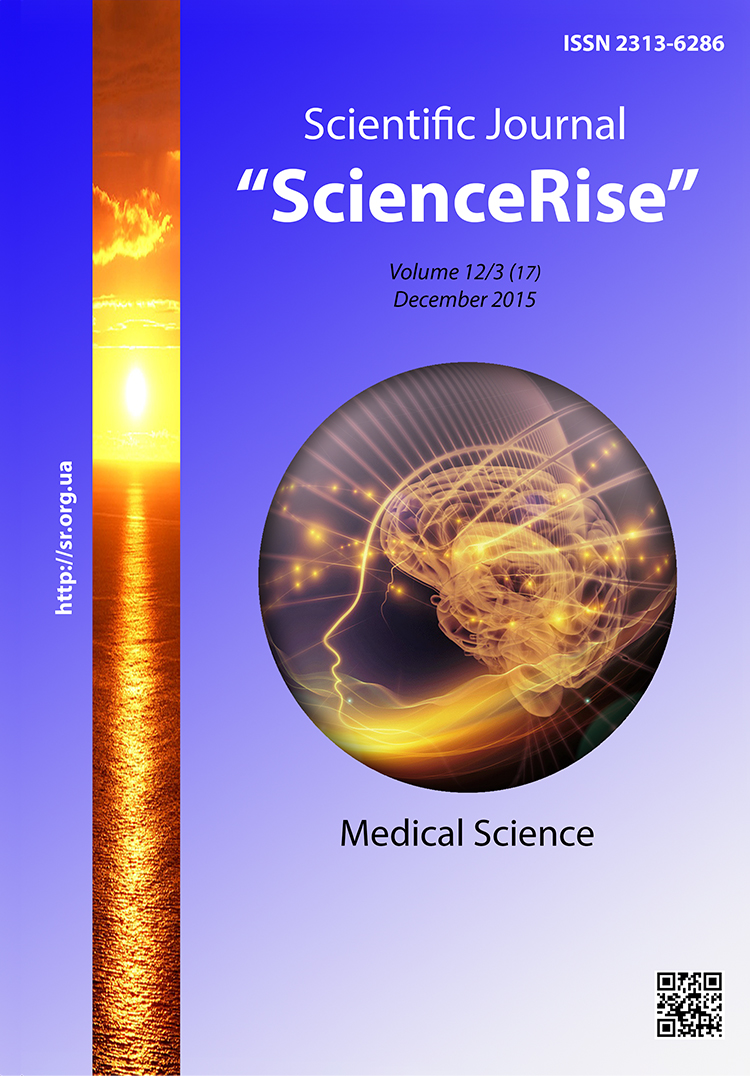Clinical and typological approach to prognostication of the special features of recurrent depressive disorder
DOI:
https://doi.org/10.15587/2313-8416.2015.57235Keywords:
recurrent depressive disorder, clinic, clinical course, stages, phases, remissions, neurotransmitters, variants, prognosisAbstract
Aim. There was revealed a possibility to prognosticate the clinical course of recurrent depressive disorder (RDD) with the help of the study of premorbid structure, age of the beginning of disease, duration of the primary and final stage, number and duration of the phases and remissions at these stages, the syndrome dynamics special features.
Methods. There were selected 114 patients with recurrent depressive disorder (F33 за МКХ-10) who were examined by the clinical and psychopathological, anamnestic, catamnestic, analytic methods, and also the methods of mathematical statistics, factor analysis, mathematical modeling.
Result. There were determined the four clinical and typological variants of recurrent depressive disorder (RDD)- I. melancholic, II. anxious and melancholic, III. anxious and hypochondriac, IV. melancholic and dysthymic and apathetic. At analysis of these variants there were revealed the different provoking factors that preceded and attended the debut of disease. There was revealed the dynamics in the structure of the periods of improvement during disease. There was also determined the psychic state of patient in interphase period that was supplemented with residual affective symptomatology – “negative and positive affectivity” and it was the point of separation of these variants for favorable and unfavorable variant of RDD.
Conclusions. According to the results of research the recurrent depressive disorder is the disease with complicated clinical structure and heterogeneous clinical course. There were verified the four clinical and typological variants of recurrent depressive disorder: I. melancholic, II. anxious and melancholic, III. anxious and hypochondriac, IV. melancholic and dysthymic and apathetic (continual)
References
Pidkorytov, V. S. (2010). Current approachesto the treatment of"pharmaco-resistant" depression. Kharkiv: Visnik of Ukrainian neuropsychiatrist. 18 (2), 55–57.
Simon, G. E. (2000). Long-term prognosis of depression in primary care. Bull. WHO, 78 (4), 439–445.
Dikaya, T. I. (2004). On the issue of long-term multi-year depression: clinical and psychopathological features and differentiation of prolonged depression. Scientific journal Psychiatry, 4, 48–54.
Dikaya, T. I. (2004). Long-term long-term depression in the form of chronic depression: clinical and psychopathological and dynamic aspects. Scientific journal Psychiatry, 5, 26–34.
Dikaya, T. I. (2006). Prolonged and chronic endogenous depression (history of formation of the concept, content and clinical nosology evaluation): a review of litas. Scientific journal Psychiatry, 1, 49–58.
Dikaya, T. I. (2011). Clinical andpsychopathologicalfeatures anddynamic aspects ofprotractedand chronicendogenous depression. Visnik of the Russian Academy of Medical Sciences, 4, 19–25.
Krasnov, V. N. (2011). Affective spectrumdisorders. Moscow: The practice of medicine, 432.
Marneros, A., Akiskal, H. S., Angst, J., Brimarher, B. et. al. (2004). Das neurHandbuch der Bipolaren und Depressive Erkrankunen. Stuttgard; New York: Georg ThiemeVerlag, 781.
Vertogradova, O. P., Petuhov, V. (2005). Prolonged depression (laws of formation, prognosis, therapy). Social and clinical psychiatry, 4, 18–22.
Podkorytov, B. C. (2002). Depression and resistance. Journal of Psychiatry and Medical Psychology, 1, 118–124.
Mazo, E. G. (2008). Тreatment-resistant depression: current approaches to diagnosis and treatment. St. Petersburg: Bulletin of St. University, 2, 87–96.
Ivanov, M. V. (2008). Negative and cognitive disorders in endogenous psychoses: diagnostics, clinic, therapy. St. Petersburg: Univ NIPNI them. V. M. Behterev ondylitis, 288.
Smulevich, A. B. (2001).Depression in general medicine: A Guide for Physicians. Moscow: Med. Inf. Agency, 256.
Smulevich, A. B. (2003). Depression in somatic and mental illnesses. Moscow: Med. Inf. Agency, 432.
Maruta, N. O., Mіshiev, V. D. (2001). Suchasnі forms depresivni rozladі. Archive of psihіatrіi, 4, 76–80.
Murphy, J. M., Laird, N. M., Monson, R. R., Sobol, A. M., Leighton, A. H. (2000). A 40-Year Perspective on the Prevalence of Depression. Archives of General Psychiatry, 57 (3), 209–215. doi: 10.1001/archpsyc.57.3.209
Fava, M. (2003). Diagnosis and definition of treatment-resistant depression. Biological Psychiatry, 53 (8), 649–659. doi: 10.1016/s0006-3223(03)00231-2
Smulevich, A. B. (2002). Prolonged treatment-resistant endogenous depression. Psychiatry andpsychopharmacology, 4, 128–132.
Baybarak, N. A. (2012). Clinical and typological variations recurrent depressive disorder with long-term course. Ukrainian Journal neuropsychiatrist, 1 (70), 34–39.
Downloads
Published
Issue
Section
License
Copyright (c) 2015 Наталя Анатоліївна Байбарак

This work is licensed under a Creative Commons Attribution 4.0 International License.
Our journal abides by the Creative Commons CC BY copyright rights and permissions for open access journals.
Authors, who are published in this journal, agree to the following conditions:
1. The authors reserve the right to authorship of the work and pass the first publication right of this work to the journal under the terms of a Creative Commons CC BY, which allows others to freely distribute the published research with the obligatory reference to the authors of the original work and the first publication of the work in this journal.
2. The authors have the right to conclude separate supplement agreements that relate to non-exclusive work distribution in the form in which it has been published by the journal (for example, to upload the work to the online storage of the journal or publish it as part of a monograph), provided that the reference to the first publication of the work in this journal is included.

